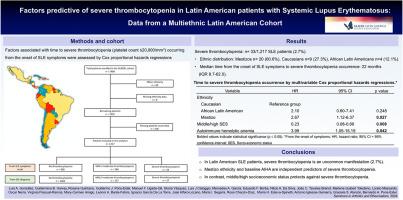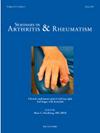预测拉丁美洲系统性红斑狼疮患者严重血小板减少的因素及其对不良预后的影响:来自拉丁美洲多种族队列的数据。
IF 4.6
2区 医学
Q1 RHEUMATOLOGY
引用次数: 0
摘要
目的研究严重血小板减少症发生的预测因素及其对系统性红斑狼疮患者损伤累积和死亡率的影响:方法:采用Cox比例危险度回归法评估从系统性红斑狼疮症状开始到发生严重血小板减少(血小板计数≤20,000/mm3)的时间相关因素。严重血小板减少症与死亡率的关系通过逻辑回归分析进行评估,而其对损害的影响则通过负二项回归进行评估:在 1217 名患者中,33 人(2.7%)在平均(标度)5.9(3.6)年的随访时间内出现了严重血小板减少症。从出现系统性红斑狼疮症状到出现严重血小板减少症的中位时间为 22 个月(IQR 8.7-62.0)。梅斯蒂索人(60.6%)是主要的种族群体,其次是白种人(27.3%),而非洲裔拉美人的发病率最低(12.1%)。通过多变量分析,梅斯蒂索种族(HR 2.67,95% CI 1.12-6.37,p = 0.027)和基线时的自身免疫性溶血性贫血(AIHA)(HR 3.99;95% CI 1.05-15.19,p = 0.042)与患者的寿命缩短有关。042)与较短的严重血小板减少症发生时间相关,而中/高社会经济地位(HR 0.23;95% CI 0.08-0.69,p = 0.008)与较长的时间相关。严重血小板减少既不会造成损害,也不会导致死亡:结论:严重血小板减少症发生在系统性红斑狼疮的早期。结论:严重血小板减少症发生在系统性红斑狼疮的早期病程中。梅斯蒂索种族和基线时的AIHA是预测严重血小板减少症发生时间缩短的独立因素,而中/高社会经济地位似乎对严重血小板减少症的发生具有保护作用。损害和死亡率似乎不受严重血小板减少症发生的影响。本文章由计算机程序翻译,如有差异,请以英文原文为准。

Factors predictive of severe thrombocytopenia and its impact on poor outcomes in Latin American patients with systemic lupus erythematosus: Data from a multiethnic Latin American cohort
Objective
To examine the predictors of the occurrence of severe thrombocytopenia and its impact on damage accrual and mortality in SLE patients.
Methods
Factors associated with time to severe thrombocytopenia (platelet count ≤20,000/mm3) occurring from the onset of SLE symptoms were assessed by Cox proportional hazards regressions. The association of severe thrombocytopenia with mortality was evaluated by logistic regression analyses while its impact on damage was by negative binomial regression.
Results
Of 1,217 patients, 33 (2.7%) developed severe thrombocytopenia over a mean (SD) follow-up time of 5.9 (3.6) years. The median time from the onset of SLE symptoms to severe thrombocytopenia occurrence was 22 months (IQR 8.7–62.0). Mestizo (60.6%) was the predominant ethnic group, followed by Caucasian (27.3%), while African Latin American exhibited the lowest frequency (12.1%). By multivariable analysis, Mestizo ethnicity (HR 2.67, 95% CI 1.12–6.37, p = 0.027), and autoimmune hemolytic anemia (AIHA) at baseline (HR 3.99; 95% CI 1.05–15.19, p = 0.042) were associated with a shorter time to the occurrence of severe thrombocytopenia while middle/high socioeconomic status (HR 0.23; 95% CI 0.08–0.69, p = 0.008) was associated with a longer time. Severe thrombocytopenia contributed neither to damage nor to mortality.
Conclusions
Severe thrombocytopenia occurs during the early course of SLE. Mestizo ethnicity and AIHA at baseline emerged as independent predictors of a shorter time to severe thrombocytopenia occurrence while a middle/high socioeconomic status seems to be protective against its occurrence. Damage and mortality did not seem to be impacted by the occurrence of severe thrombocytopenia.
求助全文
通过发布文献求助,成功后即可免费获取论文全文。
去求助
来源期刊
CiteScore
9.20
自引率
4.00%
发文量
176
审稿时长
46 days
期刊介绍:
Seminars in Arthritis and Rheumatism provides access to the highest-quality clinical, therapeutic and translational research about arthritis, rheumatology and musculoskeletal disorders that affect the joints and connective tissue. Each bimonthly issue includes articles giving you the latest diagnostic criteria, consensus statements, systematic reviews and meta-analyses as well as clinical and translational research studies. Read this journal for the latest groundbreaking research and to gain insights from scientists and clinicians on the management and treatment of musculoskeletal and autoimmune rheumatologic diseases. The journal is of interest to rheumatologists, orthopedic surgeons, internal medicine physicians, immunologists and specialists in bone and mineral metabolism.

 求助内容:
求助内容: 应助结果提醒方式:
应助结果提醒方式:


